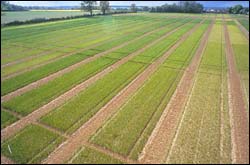Historical crop samples link changes in wheat disease to air pollution

Aerial picture of the Broadbalk experiment
Scientists at Rothamsted Research in Harpenden (1) and the University of Reading have been able to recover DNA from crop diseases on wheat samples stored as part of a Victorian field experiment (2). Using this DNA, they have discovered how changes in air pollution over the last 160 years have affected fungal diseases on our wheat crops.
The most damaging wheat disease in Europe is leaf blotch, caused by two different fungal species, Phaeosphaeria nodorum and Mycosphaerella graminicola. These species cause the loss of millions of tonnes of grain worldwide each year. Changes in the importance of these two species have been reported in the UK and elsewhere but the reason for this has remained unclear.
Dr Bart Fraaije and his colleagues looked at straw samples archived from the Broadbalk experiment, the world’s oldest, continually-running field experiment, which was set up in 1843 to investigate the effect of fertilisers on crop yields and the soil. They were able to extract fungal DNA from the straw, enabling them to carefully track changes in the populations of the two fungi since Broadbalk’s inception over 160 years ago.
Their results, which are published today (3), showed that changes in the relative abundance of the diseases are strongly linked to changes in the atmospheric emissions of sulphur dioxide (SO2). As SO2 emissions rose during and after the industrial revolution, P. nodorum became abundant, whilst M. graminicola was scarce. However, coal burning has declined dramatically over the past 20 years, leading to a decline in SO2 emissions and the situation is now reversed, with M. graminicola more common.
Pollutants are known to affect both plants and the diseases that attack them. “Gardeners have long suspected that reduced air pollution is to blame for the increase in black spot on their roses,” says Bart Fraaije “but you need a long term data set, such as that generated by the Broadbalk experiment, if you are going to investigate such associations more rigorously. Similar research on a wider range of organisms would help us to assess the impact of environmental change on biodiversity or to predict disease outbreaks.”
1) The Broadbalk experiment is the longest continually-running field experiment in the world. It was originally set up in 1843 to study the impact of different fertiliser regimes on crop yields and soil health but the data it provides us with has been used in many other ways. (www.rothamsted.bbsrc.ac.uk/resources/TheRothamstedArchive.html)
2) Rothamsted Research (www.rothamsted.ac.uk) is one of the largest agricultural research institutes in the country and is sponsored by the BBSRC.
Media Contact
All latest news from the category: Agricultural and Forestry Science
Newest articles

Properties of new materials for microchips
… can now be measured well. Reseachers of Delft University of Technology demonstrated measuring performance properties of ultrathin silicon membranes. Making ever smaller and more powerful chips requires new ultrathin…

Floating solar’s potential
… to support sustainable development by addressing climate, water, and energy goals holistically. A new study published this week in Nature Energy raises the potential for floating solar photovoltaics (FPV)…

Skyrmions move at record speeds
… a step towards the computing of the future. An international research team led by scientists from the CNRS1 has discovered that the magnetic nanobubbles2 known as skyrmions can be…





















